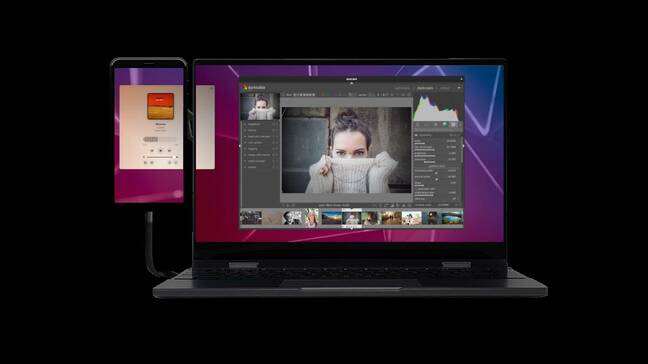This article is more than 1 year old
Puri.sm puts out LapDock for its Librem 5 smartphone
If a phone is as mighty as a laptop, why not make it convertible and use it as one
Freedom and privacy-oriented kit vendor Puri.sm has put out a device that turns its Librem 5 smartphone into a laptop.
The Californian vendor said the new piece of kit joins (pun intended) its catalog of all-Free-Software based laptops and smartphones: the LapDock. Puri.sm doesn't manufacture the new device itself – instead, it's a partnership with another Californian company, Nex Computer.
The LapDock Kit comprises a NexDock 360 dock, plus a short USB-C cable and a cunning magnetic mount for the phone, which enables the combined device to have both screens visible and usable as a whole, for those of us not blessed with a Beeblebroxian number of arms.
Puri.sm has sold all-FOSS laptops for almost a decade. In 2021, we covered its new Linux-based smartphone, the Librem 5. Last year, its founder and CEO talked to The Reg and explained about its hardware and software.
The enabling technology here is that the Librem smartphones and laptops run very closely-related OSes. If you don't read the company's description closely enough, you might be forgiven for coming away with the impression that it's the same OS: the company's in-house Linux distro, PureOS, which you can download and run on your own PC.
That distro, PureOS, is an x86-64 distro for PC-compatibles, whereas the phone has a quad-core Arm Cortex-A53 i.MX8M SoC. So, at the very least, there are two editions of the distro: an x86-64 one for generic PCs, and an Arm one for the Librem phone. As far as we can tell, the Arm edition of the OS doesn't run on any other vendors' devices.
Even so, this is a significant achievement: both PCs and Phones run PureOS 10, based on Debian 11, and running shells based on GNOME: GNOME Shell 40 on the desktop, and Phosh on the phone.
The company talks honestly about the experience of convergence, meaning using the phone as a desktop-type device – including snippets of config files and so on. We enjoyed reading this, and we recommend the company's blog posts about the early experience, as well as the goals.
The latter post points out that technologically, this isn't new – people were using the Motorola Atrix LapDock to create Raspberry Pi-powered laptops a full decade ago, and the Reg FOSS desk personally tried out a RISC OS laptop built this way at the time. It had no power management, and you needed quite a few cables, but it worked and was entirely usable. A Raspberry Pi 4 version is much more usable with Linux, and is faster than a Librem 5.
The Cortex-A53 powered Librem 5 is not a very powerful phone by contemporary standards, but in this hype-driven industry, it's easy to forget that even a relatively low-end smartphone is still a powerful computer by the standards of just a decade ago, and it's perfectly capable of daily use. Nightmarish though the USB-C standard is, for a job like this it's perfect: a single connector powers the phone, links it to the dock's keyboard and trackpad, and carries video and sound.
- Boffins build microphone safety kit to detect eavesdroppers
- The App Gap and supply chains: Purism CEO on what's ahead for the Librem 5 USA
- End-of-life smartphone? Penguins at postmarketOS aim to revive it
- Google, Facebook, Chaos Computer Club join forces to oppose German state spyware
A decade ago, this vulture pointed at some fixes for the Surface RT. Some Windows Phones were actually pretty good. Rather than trying to remedy its issues, Microsoft simply killed off Windows Phone. The era of a phone that can also be a tablet or a full computer is arriving, thanks to FOSS. Microsoft's decision might have been premature. ®

